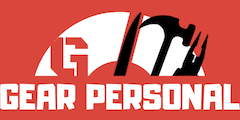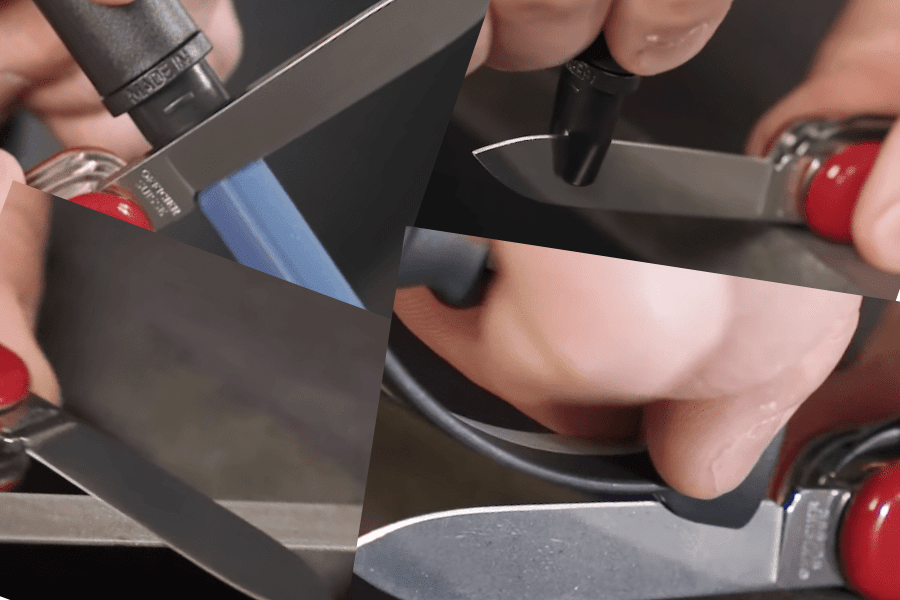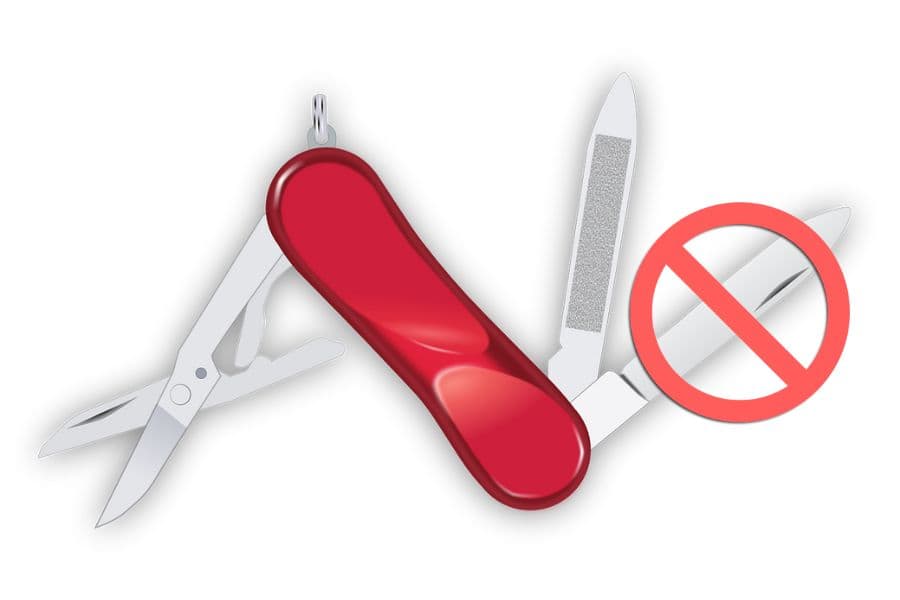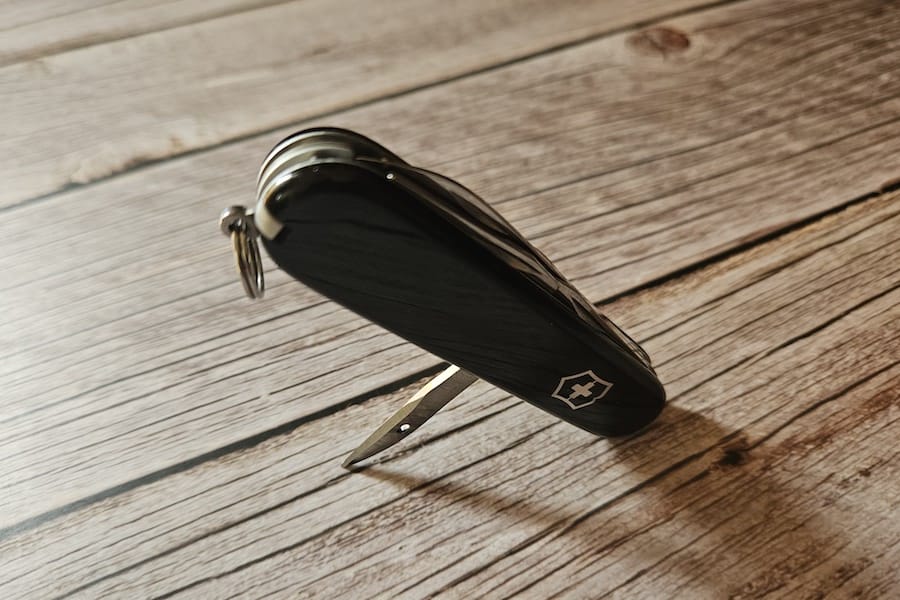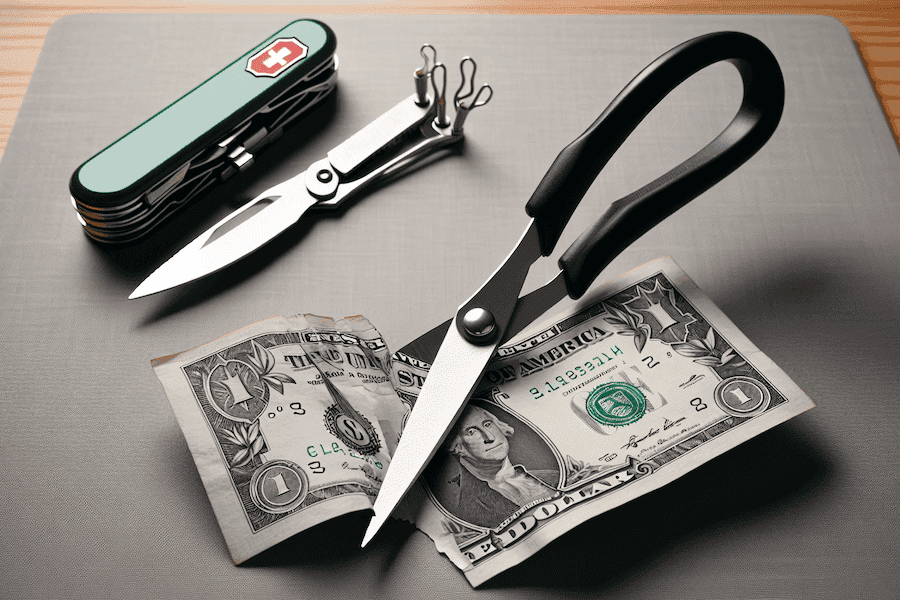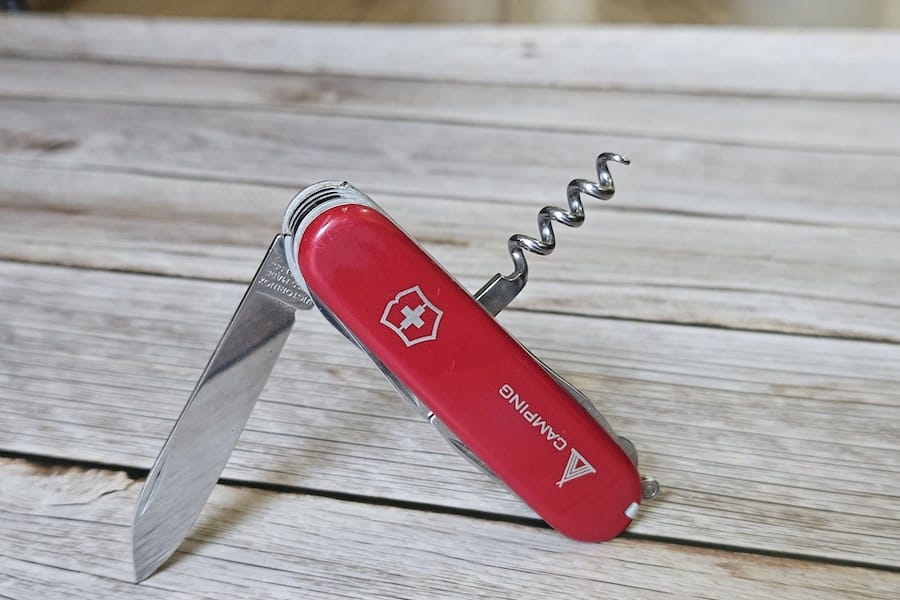I have 20-year-old Swiss Army Knives that cut as good as new! The secret? Sharpening the blades regularly or occasionally depending on usage.
It is quite easy to keep the blade slicing through anything if only you know how to keep it sharp!
Why easy? That is because Victorinox has already provided the tools tailor-made just for that purpose.
And yes, you can sharpen the blades in the traditional way using a whetstone too, just that it will need a little more time and effort.
This guide will teach you how to sharpen your Swiss Army Knife with a variety of tools, including:
- The tools provided by Victorinox
- Sharpening stone (whetstone)
- Generic knife sharpeners from other reputable manufacturers
Sharpening a SAK Blade with Victorinox Sharpy
Victorinox Small Knife Sharpener which is often referred to as the ‘Sharpy‘ is the best and the easiest way to sharpen the blade of a Swiss Army Knife.
Are you a novice with knives and know nothing about sharpening? This is the tool to have. Confused about the angle of sharpening? Don’t worry, the Sharpy takes care of it. This video describes how to use it.
How the Victorinox Sharpy Works?
The Sharpy works as a pull-thru blade sharpener and consists of v-shaped carbide plates that sits just at the optimum angle for any SAK blade.
Plus, the handle is ergonomic enough for a solid grip while using the tool. It just needs a few strokes to get the blade sharp.
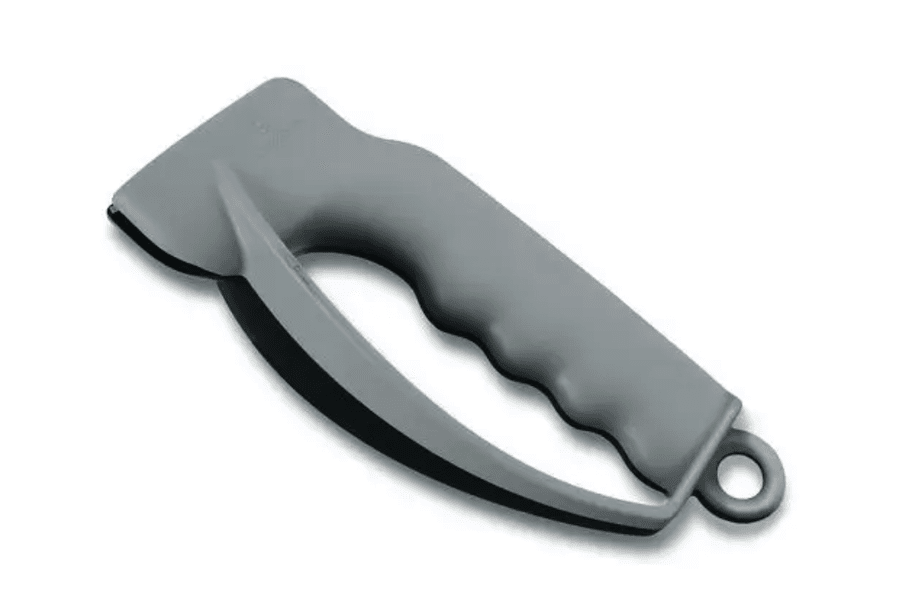
- Position the knife on a secure non-slip surface, with its cutting edge facing upwards. The apex of the blade should rise slightly above it.
- Gently grasp the knife by its handle and apply even pressure as you draw out the sharpener across the cutting edge two to four times.
- Repeat the process two to six times with reduced force in order to achieve a polished appearance.
You can get the Victorinox Sharpy on this Amazon listing.
Note that Victorinox also has a larger variant of the Sharpy in case you have bigger hands. The larger one (here on Amazon) is more suitable for larger SAKs and Vic Kitchen knives.
Sharpening the scissors of a Swiss Army Knife is a bit tricky. The process is not the same as that of the blade, as the bevel of the scissors’ blades has a different shape. However, with some patience and practice, the scissors can be sharpened as explained in this post.
You don’t need anything more if your requirement is just keeping the SAK blade sharp. However, if you want to know about other more versatile options available, then keep reading.
Sharpening a SAK Blade with Victorinox Dual-Knife Sharpener
The Victorinox Dual Knife Sharpener looks like a pen. But don’t go by the looks! it can do more than what the Sharpy can.
Just like the Sharpy, the Dual Knife Sharpener also has the pull-thru feature of the v-shaped notch with ceramic discs. And it also has a grinding stone (or rod).
The video below explains clearly how to get your SAK razor-sharp with the Dual Knife Sharpener.
I got the Dual-Knife Sharpener from Amazon quite cheap. This is my go-to sharpener for all Swiss Army Knives! I have had this for almost a decade now, and it has helped to keep all my SAK blades sharp even today.
How does the Dual-Knife Sharpener differ from Sharpy?
The grinding stone in the Dual-Knife Sharpener can even re-profile the blade if it is severely damaged!
So, if the blade has larger burrs and nicks, you will first use the grindstone to reshape and hone it. Then you will use the v-shaped notch to provide the finishing.
Also, sharpening a serrated blade is easier with the grindstone than with the pull-thru v-shaped sharpener.
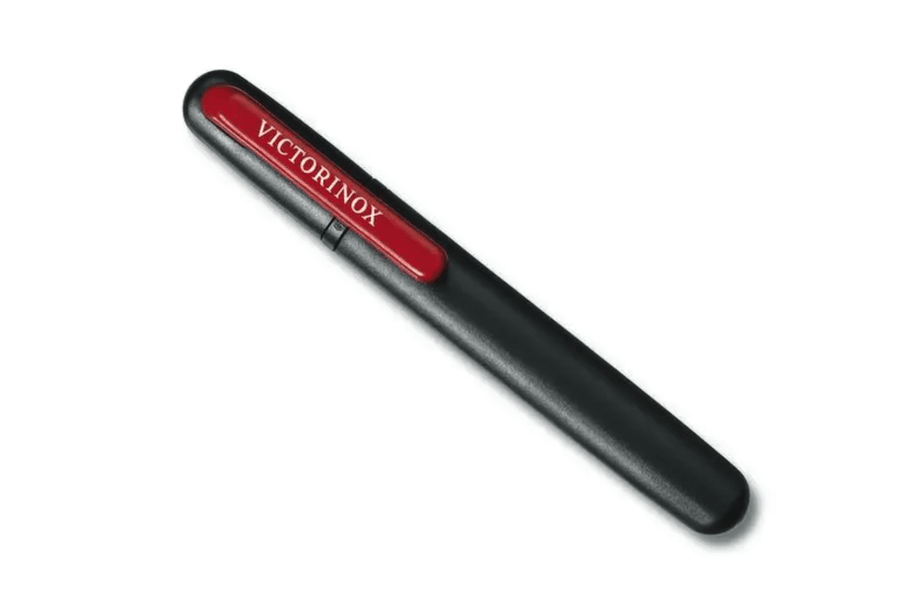
- Grasp the sharpener in your palm with one hand and gently guide the knife blade along the entire length of the grinding stone.
- Always maintain an even pressure at an angle of approximately 15-20 (more on angles later).
- Alternate sides of the blade, maintaining the same angle to ensure even sharpening.
- Now place your knife so that it stands upright on an unyielding surface, leaving the cutting edge jutting outward slightly from its tip.
- Hold the v-cut notch vertically on the sharpened edge, tilt it slightly towards the tip of the blade, and pull it gently along the cutting edge with even pressure.
- Keep repeating the process a few times until you get the desired sharpness.
The only drawback of the Victorinox Dual Knife Sharpener is that the ceramic rod is quite aggressive and eats away a lot of steel if not used carefully. However, this is the same issue you will have with any grinding/sharpening stone. On the plus side, if you know what you are doing, you can bring back to shape even severely damaged blades with it.
Sharpening a SAK Blade with Victorinox Diamond Sharpener
The Diamond Sharpener is something that Victorinox used to recommend earlier. However, I haven’t seen this available nowadays.
I always find this out-of-stock in Amazon on this listing. You may check in other online marketplaces also.

A diamond sharpener is nothing but a piece of steel with very fine diamond grit sprinkled over it, which is held in place by electrocuting a Nickel coating over it. As such, all diamond sharpeners, sometimes also referred to as diamond sharpening stones are artificially created.
You would use the Diamond Sharpener somewhat similar to how you would use a whetstone. Nobody explains it better than Felix Immler in the video below.
The main advantage of a Diamond Sharpener is that it cuts faster than other similar grindstones, and does not wear away as easily.
What angle to sharpen a Swiss Army Knife?
The angle at which you should sharpen the SAK blade is important when using a grinding stone or rod. Swiss Army Knife blades have a cutting angle of 30°-40°. That means you should sharpen each side of the blade at about 15°-20°.
The sharpening angle is taken care of when using the v-shaped notch pull-thru sharpeners. But you are on your own when using a grinding stone. Hence there is a risk of damaging the blade if you do not maintain the right angle.
By the way, did you notice in the video how Felix wipes the blade on a piece of leather? That is known as ‘stropping‘, very useful to remove burrs and residue left over on the edge of the blade.
Stropping is a technique used to sharpen the blade of a razor or other edged tool. It involves using a leather strop or strap to hone the blade by removing any small burrs or imperfections that may have formed on its edge. Stropping is an important part of maintaining the sharpness of a razor or other edged tool, and it is typically done after the blade has been honed on a sharpening stone.
The process involves pulling the blade along the length of the strop, using a specific technique that ensures that the edge of the blade makes contact with the leather at the correct angle.
By incorporating stropping into your regular maintenance routine, you can keep your tools in top condition and avoid the need for more frequent sharpening. You can learn more about the mechanics of stropping in this excellent article.
Stropping will not only restore lost levels of luster and perfection, but it may also create a more acute edge than previously possible.
If you have an old leather belt at home, you can very well use it for stropping.
Do we always need to use leather for stropping? Well, I have stropped SAK blades on canvas cloth and even on my jeans. It gets the job done, even if the result may not be as good as leather.
Sharpening a SAK Blade with a Whetstone
This is the traditional way of sharpening any knife. However, it does need some skill, precision, and patience to get the desired results.
The best thing about using a sharpening stone or whetstone is that you can sharpen as well as reprofile (more on this later) the bevel of any blade.
The worst thing is that it requires time for someone to learn the process.
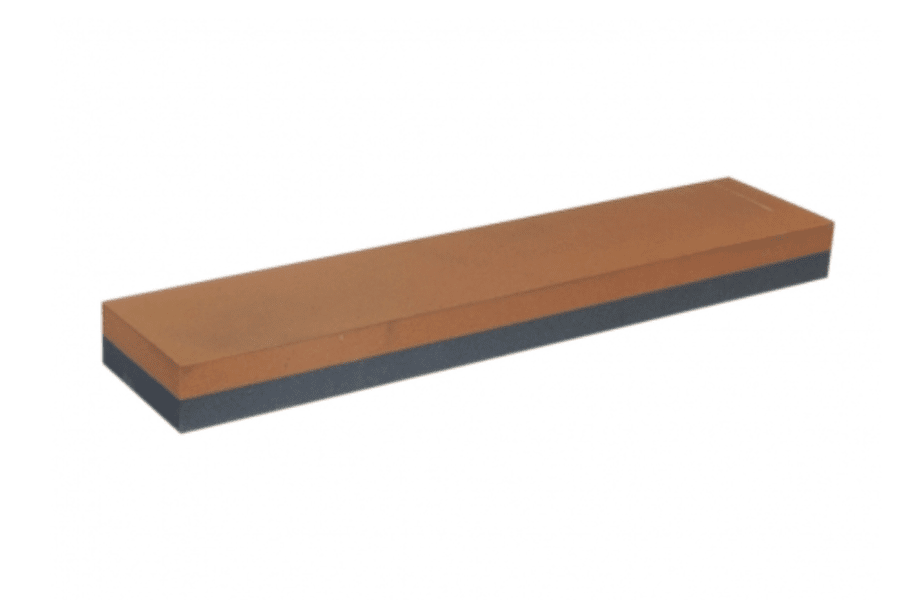
Basically, while using a whetstone, 3 things are important:
- Maintaining the correct angle of sharpening
- The direction of movement of the blade over the sharpening stone and the pressure applied
- Temperature control: keeping the blade cool with water
Sharpening stones are found of various grits, with coarse grits used for aggressive sharpening and finer grits used for polishing and finer work on the edge. Some have different grits on each side, like the Norton Combination Benchstone (Amazon link).
Remember that Victorinox steel is regarded as ‘soft’ steel (read more about it here). As such, it doesn’t take too much effort to resharpen it with a sharpening stone. This also means that too much pressure or using a coarse grit will eat away the steel easily damaging the blade.
Here is a good video that explains the process of using a whetstone:
Steps to Using a Whetstone
- Choose a coarse grit whetstone for sharpening a dull blade, and a finer grit for honing the edge. Soak the stone in water for about 10 to 15 minutes before use.
- Place the whetstone on a sturdy surface, such as a countertop or workbench, with the grit facing up.
- Hold the blade with one hand, with the edge facing away from your body, and the spine resting on the stone.
- The angle at which the blade meets the stone is critical to sharpening effectively. For a Swiss Army Knife, hold the blade at a 20-degree angle from the stone. You can also use an angle guide to help maintain a consistent angle.
- Start at the base of the blade and push it along the stone in a sweeping motion, maintaining the correct angle. Apply gentle pressure and move the blade back and forth along the stone. Use the entire length of the stone, and lift the blade at the end of each pass. Repeat this process 5 to 10 times, depending on how dull the blade is.
- Keep applying water on the whetstone and also on the blade to cool down the temperature. The steel will deform if it gets too hot.
- Once you have sharpened one side, flip the blade over and repeat the process on the other side.
- After sharpening, you can hone the edge by using a finer grit stone. Follow the same process as before, but use lighter pressure and fewer passes.
- ‘Stropping’ the blade with leather will remove any metal particles or debris that may have accumulated during sharpening.
- You can test the sharpness of the blade by gently running your thumb along the edge. Be careful not to cut yourself! If the blade is not sharp enough, repeat the sharpening and honing process.
It’s not hard to learn how to hand-grind to sharpen with a whetstone. With patience and effort, it can be easily accomplished.
How to Sharpen a Swiss Army Knife Without a Stone?
Don’t have a sharpening stone but still want to sharpen your SAK? Here are a few other materials you can try:
- Ceramic mug or plate: Turn a ceramic mug or plate upside down and use the unglazed ring on the bottom to sharpen your SAK. Hold the SAK blade at a 20-degree angle and draw it down the unglazed ring in a sweeping motion, repeating on the other side of the blade.
- Leather belt: Use the leather belt you’re wearing to sharpen your SAK blade. Hold the blade at a 20-degree angle and draw it down the belt, pulling the blade away from the sharp edge. Repeat on the other side of the blade. This is similar to stropping the blade.
- Sandpaper or emery cloth: Wrap a piece of sandpaper or emery cloth around a pencil or other cylindrical object, then hold the pencil with one hand and draw the SAK blade down the sandpaper or emery cloth in a sweeping motion, repeating on the other side of the blade.
Blade reprofiling is a process of altering the shape of a blade by removing metal from the edge to create a new bevel angle. This is done in order to change the cutting characteristics of the blade or to correct a damaged or worn edge. The goal of reprofiling is to create a new edge that is straight, even, and sharp.
Reprofiling is done using abrasive materials, such as the grinding wheel, whetstone with coarse grit, etc. to remove metal from the blade. The process involves a series of grinding and honing steps, with the blade being carefully monitored and tested at each stage to ensure that the desired bevel angle and sharpness are achieved.
The amount of metal that is removed depends on the extent of the reprofiling that is required. If the blade is severely damaged or worn, more metal will need to be removed to create a new edge.
Reprofiling is most commonly done on Swiss Army Knives that have been used for heavy-duty cutting or chopping.
Using Sharpening Tools and Kits from Other Manufacturers
The tools from Victorinox are best suited for sharpening any Swiss Army Knife, as these have been designed specifically for that purpose.
But if you have other knives too in addition to SAKs, then you will probably be looking for a complete sharpening kit that can be effectively used on any knife.
In that case, there are two tool sets that you can have a look at. Both of these are extremely versatile, provide an adjustable angle guide, and can be used to sharpen not only a knife blade but anything that has a sharp edge, including serrated blades, scissors, awl, darts, fishhooks, etc.
Spyderco Tri-Angle Sharpmaker
This is a versatile and easy-to-use sharpening system that can help users maintain the sharpness and edge retention of their cutting tools.
It consists of two sets of high-alumina ceramic stones, each set containing two triangular rods with different grits on each side, and a set of brass safety rods.
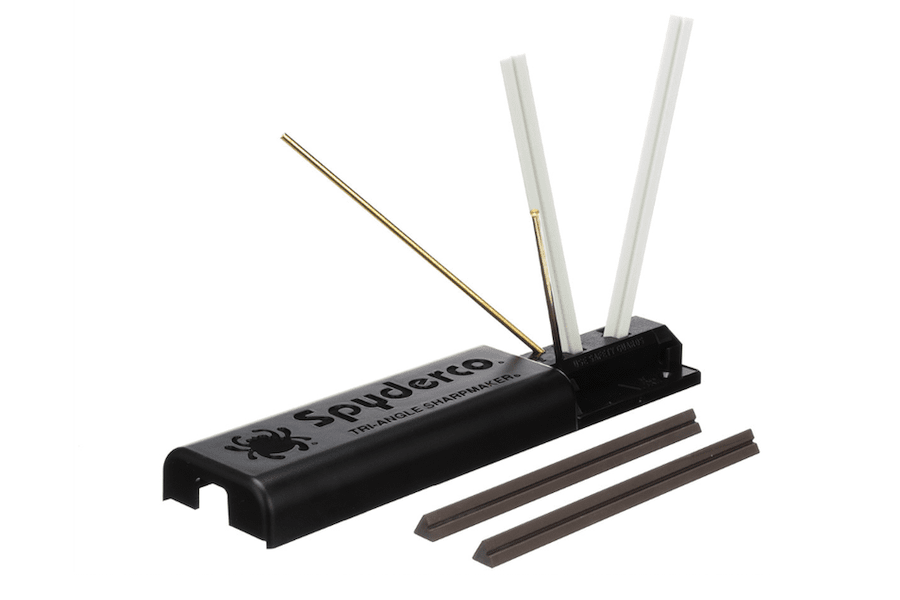
The two sets of stones allow users to first sharpen their knives with the coarser grits and then refine the edges with the finer grits. The brass safety rods serve as a guide to help maintain a consistent angle during the sharpening process.
You can find the Tri-Angle Sharpmaker on this Amazon listing.
Lansky Professional Sharpening System
This is a guided knife sharpening system designed to help users sharpen and maintain the edges of their knives and other cutting tools.
It consists of a clamp that holds the blade securely in place, and a set of hones or sharpening stones of different grits or coarseness levels, ranging from coarse to fine.
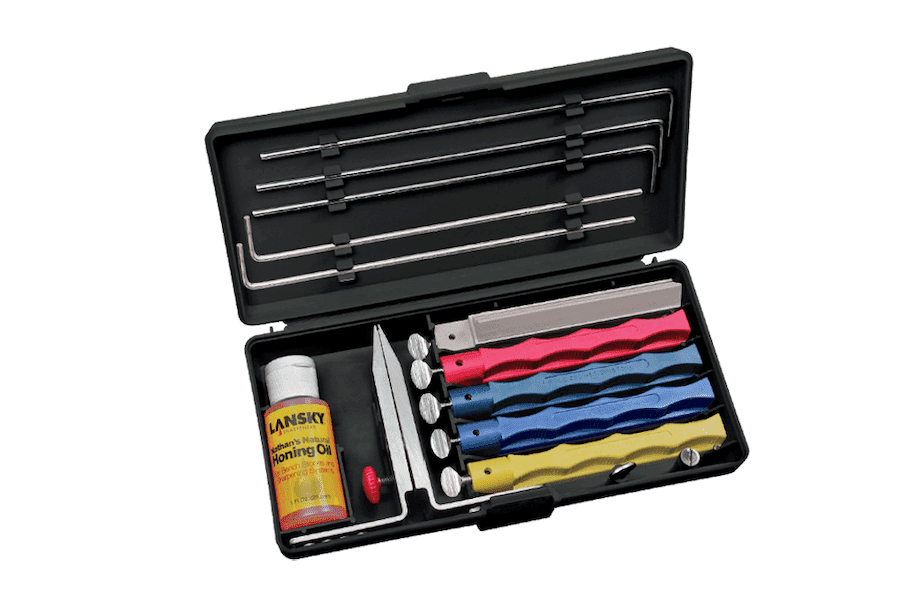
The coarse stones are used to remove any nicks or chips in the blade, while the finer stones are used to refine the edge and achieve a sharper blade. The angle guide system allows the user to maintain a consistent angle while sharpening.
Check out the Lansky Professional Sharpening System here on Amazon.
Sharpening Tools to Avoid
Swiss Army Knives have unique and precise blade edges, which require specific sharpening tools for optimal performance.
There are some generic sharpening tools that you should not use while sharpening a Swiss Army Knife. These will not only fail to sharpen the blade properly but may also damage the bevel of the blade.
- Electric grinders: Electric grinders can quickly remove material from the blade, which can damage the edge and change the shape of the blade.
- Belt sanders: Similar to electric grinders, belt sanders can quickly remove material and can cause damage to the blade if not used correctly.
- Dremel tools: While Dremel tools can be useful for many tasks, they are not recommended for sharpening Swiss Army Knives, as they can easily remove too much material and alter the shape of the blade.
- Coarse sharpening stones: Coarse sharpening stones can remove too much material from the blade and create an uneven edge.
- Cheap kitchen knife sharpeners: Cheap sharpeners often have abrasive surfaces that are too rough for a Swiss Army Knife, which can scratch or damage the blade.
Benefits of Sharpening a Swiss Army Knife
Sharpening a Swiss Army Knife can provide many benefits:
- Improved cutting performance: Sharpening a Swiss Army Knife can restore the sharpness of the blade, allowing it to cut more effectively and efficiently.
- Increased safety: A dull blade can be more dangerous than a sharp one, as it requires more force to cut and can slip, causing injury. Sharpening the blade can reduce the risk of accidents and improve safety.
- Extended lifespan: Regular sharpening can extend the lifespan of a Swiss Army Knife, as it helps prevent the blade from becoming too worn or damaged.
- Cost-effective: Sharpening a Swiss Army Knife is a cost-effective alternative to replacing it. By maintaining the blade, you can avoid the expense of buying a new knife.
- Versatility: A sharp Swiss Army Knife can be used for a variety of tasks, from cutting rope and opening packages to preparing food and trimming branches. Sharpening the blade can help ensure that it is always ready for any task.
- Sense of accomplishment: Sharpening a Swiss Army Knife can be a satisfying task, as it allows you to take care of your tools and maintain their performance.
While sharpening a Swiss Army Knife is not a very complicated task, still following some basic safety guidelines will prevent unwanted accidents or injury:
- When sharpening, keep the blade pointing away from your body to prevent accidental cuts.
- Apply even pressure on the blade when sharpening to avoid any accidental slips.
- Work in a well-lit area with sufficient ventilation for proper visibility.
- Take regular breaks while sharpening to avoid overworking the muscles of your hand, arm, and shoulder.
Final Thoughts!
Cutting with a Swiss Army Knife is meant to be easy and with minimal effort. When it is not so, it means your knife needs sharpening.
The sharpening tools provided by Victorinox are the best suited for the task. You can also use traditional methods like a whetstone, or guided sharpening systems from Spyderco or Lansky. However, most people usually cling to whatever effective method they first learned.

Spending just a few minutes restoring your Swiss Army knife can make all the difference in how it performs.
Just like cleaning a Swiss Army Knife, keeping the blade of a Swiss Army Knife sharp is an important part of its care. With regular maintenance, it can remain a reliable and versatile tool for years to come.
